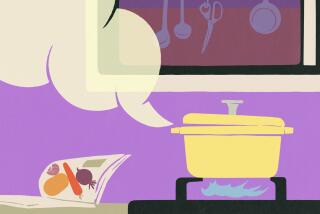Bocuse: Pure and simple
Paul Bocuse, where were you when I needed you?
In 1982, the year “Bocuse in Your Kitchen” was first published, I was working my way through Julia Child’s “Mastering the Art of French Cooking.” Of course that’s a great way to learn, but “Bocuse in Your Kitchen: Simple French Recipes for the Home Chef,” is a slim volume of essential French dishes. Cook one, and you’ve got the technique -- and you’ve got it from Paul Bocuse, chef-owner of the Michelin three-star restaurant L’Auberge du Pont de Collonges near Lyon, France, among others, and one of the most important and influential French chefs ever. In 1989 the French magazine Gault et Millau dubbed Bocuse “chef of the century.”
The French publishing house Flammarion recently reissued “Bocuse in Your Kitchen” in English in a smart little hardback edition with photographs (by Jean-Charles Vaillant) that make you want to jump in and cook. And eat. What a wonderful gift this would be for a fledgling cook.
The recipes are mostly quite simple, no longer nor more involved than necessary. The concepts are easy to grasp, and the dishes are those you’d want to include in your basic French repertoire.
You could start with “my mixed green salad (petite salade de mon jardin).” It’s an elegant little salad, with radishes, julienned celery or celery root, mâche, frisée and watercress. If you didn’t know how to make a simple vinaigrette, you learn: It’s just red wine vinegar, olive oil, salt and pepper. Simple, yes, but if that’s how Bocuse does it, it must be right.
I tried the cucumber and cream salad, not because it sounded so great, but because it looked so delicious in the photo. There’s a smart little lesson in it: Slice and salt the cucumbers, and let them stand half an hour before rinsing them and making a simple sauce of crème fraîche, lemon juice, chopped chives, salt and pepper. Bocuse writes that salting the cucumbers makes them easier to digest, but it also improves their texture -- it’s an elegant little dish.
--
It doesn’t get any easier
TROUT or whiting meunière worked beautifully, and it’s simplicity itself. Just salt and pepper the whole fish, roll them in flour, shake off the excess, and cook them in butter with a little garlic, about 6 minutes on each side. Sprinkle with chopped parsley and garnish with lemon wedges. Parfait. Now we know meunière. Somehow, Child didn’t see fit to include the dish, seminal though it is, in “Mastering the Art.”
Steak “wine-grower’s style” (entrecôte vigneronne) is something I had made a hundred times before, but now I’ll never do it any other way. Bocuse has us cook the steak in butter, and while it’s resting, brown lots of chopped shallots and onion (three shallots and a whole onion) in the butter, add half a cup of wine, boil a minute or two until thickened and season to taste. Et voilà. It never would have occurred to me to use so much onion, but that’s what gives the sauce it’s wonderful flavor and body.
The steak is terrific with a potato crepe (crique), which looks kind of fabulous and tricky in the photo, but it couldn’t have been easier. Also excellent was Bocuse’s pre- Pixar, pre-Thomas Keller version of bayaldi (spelled differently too) -- a baked dish of layered eggplant, zucchini, onion and tomato. (In the film “Ratatouille,” the amped-up version of the peasant dish ratatouille that wins the critic’s heart is actually Keller’s recipe for the Turkish-inspired dish bayaldi). Bocuse offers two versions, one made with butter and cheese, the other with olive oil, no cheese. The Californian in me preferred the lighter version, which was also, by the way, gorgeous.
--
A few missteps
IS the book perfect? Alas, no.
The trout meunière recipe neglectsed to list garlic in the ingredients. (I just added one clove, chopped, where the instructions said “
add the fish and the garlic.”) The ingredients for the bayaldi yielded too much zucchini in relation to eggplant for proper layering. And the instruction for slicing converts the specified size from 1 centimeter to half-inch slices, when, in fact, a centimeter is closer to three-eighths of an inch. The dish turned out much nicer when the slices were as thin as they would have been for anyone following the metric measurements. The recipe for steak winegrower’s style says to cook the steak for 6 minutes on each side over moderately high heat for medium-rare, but Bocuse doesn’t tell us how thick the steak should be for that cooking time. (The recipe, as it appears in the book, calls simply for 1 boneless rib steak weighing 1 3/4 pounds; we’ve adjusted our version.)
The cooking time was way off on the recipe for cherry clafouti and even when adjusted, it didn’t wow me. There’s nothing wrong with it, but it’s the very cakey style of clafouti (as opposed the custardy sort), and it was just barely sweet -- not even enough for my very sugar-sensitive palate. I did love how easy it was, though.
Also, I wish Bocuse had written head notes for at least some of the recipes -- how marvelous it would be to read his thoughts on a dish. As it is, we have to be satisfied with his introduction.
But all that’s OK, because there’s so much of interest. The rabbit rillettes look brilliant and are very easy. The pot-roasted chicken is absolutely gorgeous, surrounded in the pot with little caramelized onions and potatoes. Boiled pork dinner (potée au chou) looks irresistible for wintertime, and the pot au feuis smarter than Child’s for the simple reason that whereas Child has you boil all the meats and poultry in meat stock, Bocuse has you make stock as you go by boiling them in water.
What’s brilliant here is that Bocuse has gone straight to the essence of each dish, giving recipes for the way home cooks really cook, yet without the slightest compromise. At the same time, he brings his unique sensibility and irrefutable authority to the recipes.
All of which is to say, I may just learn how to cook all over again.
--
brenner@latimes.com
--
Bayaldi
Total time: About 1 hour and 10 minutes
Servings: 6
Note: Adapted from “Bocuse in your Kitchen” by Paul Bocuse. Instead of making layers as described below, you can simply make parallel lines of overlapping vegetables, as shown in the photo; you can bake them in individual baking dishes rather than one large one.
4 medium zucchini, weighing about 1 1/2 pounds
2 small eggplants or 1 large one, weighing about 1 1/4 pounds
1 1/4 pounds tomatoes
1 large onion
Butter for the baking dish
1 clove garlic, peeled and chopped fine
1 teaspoon thyme leaves
1/2 bay leaf, crushed
Salt, pepper
1/3 cup olive oil
1. Heat the oven to 425 degrees. Wash the zucchini, eggplant and tomatoes and wipe them dry. Cut them and the onions into slices about three-eighths-inch thick (if using a large eggplant rather than two smaller ones, cut it in half lengthwise before slicing). Keep all the vegetables separate from one another.
2. Butter a large baking dish (preferably earthenware or enameled cast iron). Cover the bottom of the dish with the onions. Then make a layer of zucchini and sprinkle with a little garlic, thyme, bay leaf, salt and pepper. Next, layer the eggplant, then the tomato. Season each layer as you did the zucchini.
3. Pour the oil over the surface of the vegetables and bake until golden brown, about 50 minutes to 1 hour. (If the vegetables dry out during the first 30 minutes of baking, cover them with foil; remove the foil during the last 10 minutes of baking.)
Each serving: 161 calories; 3 grams protein; 13 grams carbohydrates; 5 grams fiber; 12 grams fat; 2 grams saturated fat; 0 cholesterol; 14 mg. sodium.
--
Steak winegrower’s style (Entrecôte vigneronne)
Total time: About 40 minutes
Servings: 4
Note: Adapted from “Bocuse in Your Kitchen” by Paul Bocuse. Cooking time will vary depending on the size and thickness of each steak.
1 or 2 boneless rib-eye steaks (about 1 3/4 -inch thick, 1 3/4 pounds total)
3 shallots
1 medium onion
2 anchovy fillets
3 1/2 tablespoons butter
Salt, pepper
1/2 cup red wine
1. Cut off any excess fat from around the steak. Finely chop the shallots, onion and anchovies, by hand or using a food processor. Place them all in a bowl and reserve for making the sauce.
2. Melt the butter in a large frying pan over medium-high heat until very hot. Salt and pepper the steak on both sides, then place it in the pan. Cook the steak for 6 minutes on each side if you like it rare, 8 minutes on each side for medium rare. When done, lift the meat from the pan and keep warm while making the sauce.
3. Stir the chopped onion mixture into the pan and cook for about 5 minutes, or until the onions soften and start to brown. Stir in the wine, bring to a boil and boil for 1 to 2 minutes, or until the sauce thickens slightly; add salt and pepper if needed.
4. You can either serve the steak as it is on a hot platter and slice it at the table with the sauce in a sauce boat on the side, or slice the meat, spoon a little sauce onto each dinner plate, place the slices of steak on top, and serve with any extra sauce in the sauce boat.
Each serving: 601 calories; 38 grams protein; 5 grams carbohydrates; 0 fiber; 45 grams fat; 20 grams saturated fat; 153 mg. cholesterol; 174 mg. sodium.
--
Potato crepe (crique)
Total time: About 25 minutes
Servings: 2 to 3
Note: Adapted from “Bocuse in Your Kitchen” by Paul Bocuse. “Serve as a garnish with meat or as a light lunch,” Bocuse writes, “accompanied by a green salad flavored with a little garlic, if you like it, and an oil and vinegar dressing made with olive oil and seasoned with fine chopped fresh herbs (parsley, chervil, chives, tarragon, etc.), depending on what’s in season.”
1 pound russet potatoes
1 egg
1/2 teaspoon salt
Freshly ground black pepper to taste
3 tablespoons olive oil, divided
1. Wash the potatoes, wipe them dry and peel them (do not wash after peeling, but wipe them off with a dry cloth if necessary). Using a box grater, grate the potatoes coarsely. Place them in a bowl with the egg, salt and pepper and mix well. All this should be done just before cooking them.
2. Heat 2 tablespoons of the oil in a 12-inch frying pan (preferably cast-iron). When it is very hot, add all the grated potatoes and spread them out with the prongs of a fork, pressing down on them lightly to make a large crepe, or pancake, of even thickness. Cook over medium-high heat for 6 to 8 minutes, or until the underside has browned, then slide the crepe out onto a large plate.
3. Place the remaining oil in the pan, then place a second plate on top of the crepe and turn it upside down. Lift off the first plate and slide the crepe back into the pan to finish cooking 6 to 8 minutes on the second side. Serve immediately.
Each of 3 servings: 256 calories; 5 grams protein; 26 grams carbohydrates; 2 grams fiber; 15 grams fat; 2 grams saturated fat; 71 mg. cholesterol; 416 mg. sodium.
More to Read
Sign up for our L.A. Times Plants newsletter
At the start of each month, get a roundup of upcoming plant-related activities and events in Southern California, along with links to tips and articles you may have missed.
You may occasionally receive promotional content from the Los Angeles Times.






